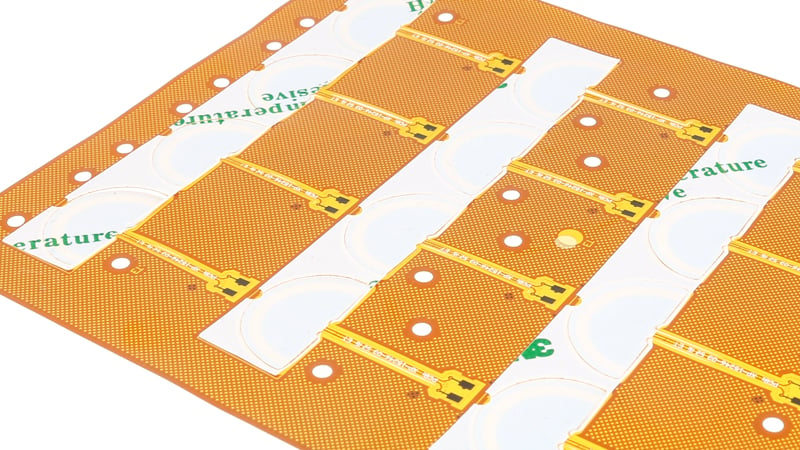One of the key components in the stack-ups for flexible circuits is adhesives. From bonding coverlays to the surface to adhering stiffeners to rigidize the circuit to create additional use applications for the circuit, adhesives hold many possibilities and can add another dimension of complexity to flexible circuits.
The most common adhesives can vary from one manufacturer to another, changing applications depending on the use cases.
Types of Adhesives
Adhesive types can vary greatly, depending on their primary use case. Typical adhesives used are epoxy or acrylic, both of which are standard and common among most PCB manufacturers. While both materials are highly reliable, they have one key mechanical difference between the two of them.

Flexible circuit board with adhesive.
When comparing the flexibility of epoxy and acrylic adhesives, both have a degree of flexibility, however, epoxy adhesives tend to be stiffer, which can be a good thing if stiffer flexibility is needed, but a bad thing if the bend application of the circuit relies on dynamic bending. Both adhesives are highly reliable and are used frequently in circuit designs.
Pressure Sensitive Adhesives (PSA)
The most common special use case adhesives is pressure sensitive adhesives (PSA), a common classification of adhesive used for situations where a circuit needs to be adhered to another material with simple pressure. This adhesive shares a common element with double-sided tape in that regard, with one side of the adhesive being stuck to the circuit and the other side having a protective film that can be peeled off to make it sticky and ready to adhere to another surface. The downside to this material is it is not resistant to high temperatures and cannot survive assembly processes. If a normal pressure-sensitive adhesive were to go through assembly, it would result in a loss of adhesion properties from the material and degradation of the adhesive. This lack of resistance to assembly processes leads to the next type of adhesive.
Assembly-Resistant Adhesives
Assembly-resistant adhesives are a classification of adhesive similar to pressure-sensitive adhesives. These adhesives are used to bond a circuit to another item, just as pressure-sensitive adhesives do. The main difference, however, is that these adhesives can go through the high temperatures of an assembly process and survive while still retaining the natural stickiness to be able to adhere to another item later on.
Anisotropic Adhesives
Another unusual adhesive is anisotropic adhesives. This classification of adhesive is primarily used when electrical conduction is required among the adhesive layer. The reason this is called anisotropic is due to the unique nature of the adhesive and how it only conducts through a singular axis, the y-axis. In contrast to that, the other axes remain electrically insulating. These types of adhesives are primarily used in situations where the pitch of the board is too fine for soldering to be possible. This is achieved by the suspension of electrically conductive partials in a matrix to orient them in that one direction, allowing conduction in only the aligned axis.
Adhesives Used in Stack-Ups
Adhesives commonly are used in stack-ups. In essence, almost every flexible circuit uses an adhesive in some form or fashion, either in the stack-up or externally. Among the stack-up, adhesives have a variety of uses such as for the main material laminate and copper, for coverlays, for bondplys, and for stiffener adhesion.
Adhesive-based laminate is a type of laminate commonly used when cost is a concern. This type of laminate is formed by bonding copper layers to laminate using adhesive. While this is certainly more economical than traditional flexible laminate, it comes at the cost of a significant increase in thickness due to the added two adhesive layers.
Bondplys operate similarly to adhesive-based laminates. Bondplys are defined as a material where the laminate is surrounded on either side by an adhesive that then conforms when pressed between layers. This can be used to create more electrical insulation, or a thicker dielectric if it is needed for achieving impedance values. Both the laminate and adhesive thicknesses can vary, with adhesives largely changing to accommodate heavier copper weights to properly bond together inner layers.
Coverlays are materials meant to protect surface copper and to shield the copper from the environment. This is done by adhering a polyimide material to the surface of a flexible circuit with openings for pads, holes, or anything else necessary to access. The adhesive portions of coverlays vary based on the stack-up, with heavier copper weights requiring larger thicknesses of adhesives to properly conform and adhere to the circuits and design.
Stiffeners are rigid layers added to a circuit board to achieve mechanical support and rigid sections on flexible circuit boards. Stiffeners adhere to the flexible circuit board with an adhesive that is lined up to the stiffener and can allow it to bond to the coverlay of the circuit to create a rigidized section of the board.
Summary
Adhesives play a key role in the manufacture and assembly of flexible circuits. Whether they are epoxy or adhesive, used for special scenarios to create thermal or electrical conductivity, or used in the stack-up, flexible circuits largely cannot exist without adhesives. Understanding the purpose of adhesives both inside and outside the stack-up can greatly help in the design of circuits, especially when specific product requirements are present.
Key Takeaways
- Adhesives are essential in flexible circuit manufacturing: Whether used for bonding coverlays, attaching stiffeners, or creating additional conductive pathways, adhesives play a crucial role in ensuring circuit durability and functionality.
- Different adhesives serve different purposes: Epoxy adhesives offer stiffness, while acrylic adhesives provide more flexibility, making material selection critical depending on the application’s bending requirements.
- Pressure-sensitive adhesives (PSA) provide easy attachment: These adhesives function similarly to double-sided tape but are not suitable for high-temperature assembly processes due to their limited heat resistance.
- Specialty adhesives enable advanced functionality: Assembly-resistant adhesives maintain adhesion even after exposure to high temperatures, while anisotropic adhesives allow electrical conduction in a single axis for fine-pitch connections.
- Adhesives impact stack-up design and performance: They are used in various layers, including laminates, bondplys, coverlays, and stiffeners, with thickness adjustments needed to accommodate different copper weights and mechanical support requirements.
















